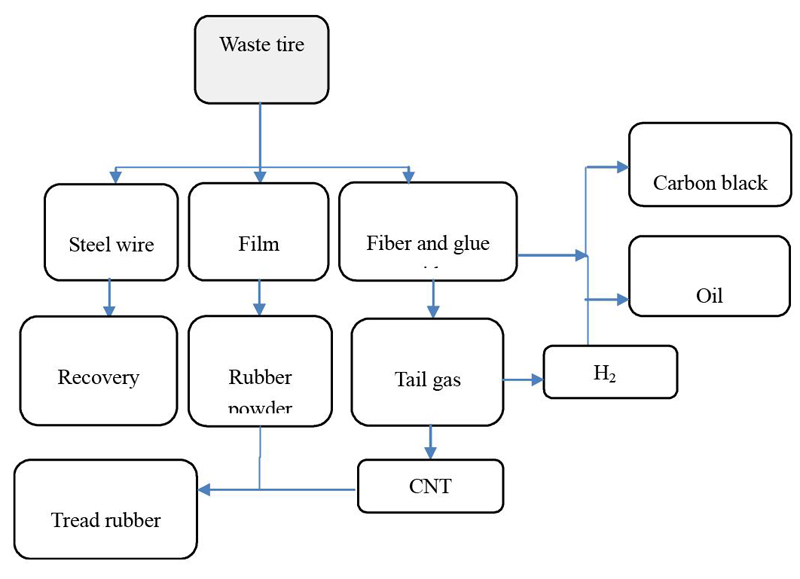Li Yongkang Zhu Junyi Xu Xiwei Zhu Danyang Jiao Chunyu Luo Haofang


摘 要:With the swift development of the automobile industry, the amount of waste tires has also been increasing rapidly. Based on the analysis of current recycling technology, this paper proposes to synthesize CNT from the tail gas of a smelting furnace, and then mixing CNT into rubber powder to make a new type of rubber and tires. After actual measurement, the actual service life of the tires made of the new type of rubber is more than twice the current standard.
关键词:Tire; Rubber; Carbon nanotubes;
1.Current Situation of Tire Recycling
At present, natural rubber and synthetic rubber are both used in the market. This is because the use of rubber is increasing year by year, resulting in a serious shortage of the natural rubber supply. Especially with the rapid development of the automobile industry, the use of rubber for automobile tires has increased significantly. With the increase of rubber consumption, the number of corresponding waste rubber products, especially that of waste automobile tires, has also been growing rapidly. Waste tires are piling up in various countries, especially Japan, the United States, Britain, Germany and other countries due to the pursuit of further environmental protection measures and the limitation of waste rubber recycling technology, the number of waste tires has increased year by year. These piles of waste tires not only cause environmental pollution, but also cause serious fire hazards.
China produces about 7.4 million tons of waste tires every year, mainly for producing reclaimed rubber. In 2018, the world produced about 1.5 billion waste tires, which is about 222 million tons. The reasonable and efficient recycling of waste tires, as a valuable social resource, is an effective way to alleviate the tightening supply of rubber.
The traditional recycling methods for waste rubber mainly include waste tire retreading, rubber powder preparation, carbon black preparation and use as fuel.
These methods are relatively regressive, causing certain environmental pollution in the recycling process, which is also the reason why developed countries such as Britain strictly prohibit the production of reclaimed rubber. Waste rubber is mainly used to produce recycled rubber powder in China, while it is mainly used to produce carbon black and fuel in the United States.
2.Defects of Traditional Methods
The traditional methods of rubber recovery inevitably lead to exhaust emission or insufficient combustion, resulting in secondary environmental pollution. The method commonly used in China is to draw the tail gas to a position more than 8 meters above the ground for combustion treatment. This method causes the loss of waste rubber components, reduces the recovery rate, and causes potential safety hazards due to open flames and secondary pollution of the environment due to combustion.
3.Technical Route Planning
The world produces about 222 million tons of waste tires every year. Efficient recycling of organic waste gas during the recycling process will be a new breakthrough in rubber waste recycling technology, which can not only improve the recycling rate of rubber waste, but also effectively promote environmental protection.
Composition of tail gas from waste rubber refining:
Based on the above gas composition and the application characteristics of tire tread rubber, the composition of the tail gas from waste rubber refining is similar to that of natural gas. It is therefore decided to convert the tail gas into carbon nanotubes, carbon fibers and other materials, and put them into rubber powder for refining directly, so as to recover nearly 100% of the components of waste tires. At the same time, the introduction of carbon nanotubes and carbon fibers enhances the strength, wear resistance and other properties of tires.
4.Process Route for Synthesizing CNT from Tail Gas
The tail gas is introduced into a reaction tank at 550 - 650 DEG C, and the catalyst consists of a mixture of nickel powder, iron powder and iron oxide powder; the actual product is a mixed material containing 85% CNT, carbon fiber and part of carbon black; compress and recover the product hydrogen after cooling.
5.Tire Test
Mix the prepared CNT and rubber powder proportionately to then form a carcass and a tread, , and manufacture a finished tire. The actual service life test of tires was carried out on taxis in Shenzhen, Ningbo and Thailand respectively. The actual service life test result is more than 200,000 kilometers, which is more than twice the current standard. The test results have been unanimously approved by relevant enterprises in China, Singapore, Thailand, Germany and Russia, and corresponding waste tire recycling production lines have been built.
6.Conclusion
Through experimental verification, it is feasible to synthesize CNT from the tail gas of the waste rubber refining furnace to recover the components of the tail gas. By mixing and refining the prepared CNT and rubber powder, the service life of the new type of tire is more than twice the current standard.
作者简介:
李永康 高级工程师 研究方向:新能源 。



